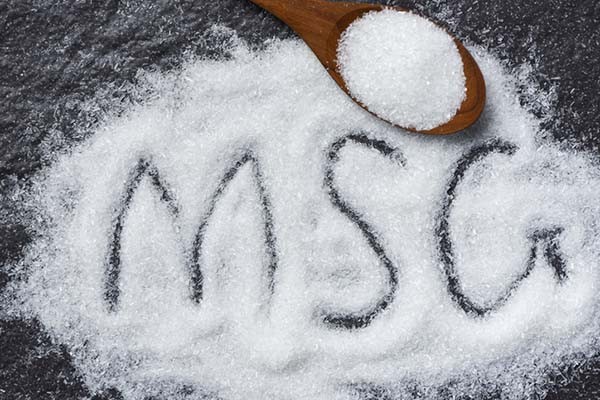 MSG crystals. Close-up of monosodium glutamate, a common food additive, showing its crystalline structure and the letters MSG drawn into the powder.
MSG crystals. Close-up of monosodium glutamate, a common food additive, showing its crystalline structure and the letters MSG drawn into the powder.
Monosodium glutamate, commonly known as MSG, often finds itself in the crosshairs of health discussions, frequently linked to Chinese food and a host of supposed negative health effects. This crystalline additive is prevalent not only in Asian cuisine but also throughout the broader food industry, enhancing the flavor of everything from restaurant dishes to your favorite packaged snacks. But what exactly is MSG, and are the concerns about its safety warranted? Let’s delve into the science and separate fact from fiction to understand why MSG gets a bad rap.
Decoding MSG: What It Is and Where It Comes From
MSG is essentially a flavor enhancer derived from the naturally occurring amino acid, L-glutamic acid. This amino acid isn’t foreign to our bodies; it’s nonessential, meaning our bodies produce it, and it’s also found abundantly in umami-rich foods we enjoy regularly. Think of the savory depth in tomatoes, the rich taste of aged Parmesan, or the earthy flavor of mushrooms – that’s glutamate at work.
The story of MSG began in 1908 when Japanese chemist Kikunae Ikeda isolated glutamate from kombu seaweed broth. His innovation led to the creation of the first manufactured MSG. Today, the production process involves fermenting starch, sugar beets, sugar cane, or molasses, transforming these simple ingredients into a white, odorless powder. This powder, MSG, can then be used just like salt to sprinkle savory flavor into dishes across global cuisines, far beyond just Southeast Asian cooking.
The Role of MSG: Why Chefs and Food Manufacturers Use It
MSG’s primary function is to amplify and enrich umami flavors in food. Umami, often described as the fifth taste alongside sweet, sour, salty, and bitter, is that savory, meaty, or broth-like sensation. Pure MSG itself doesn’t have a distinct taste, but when added to food, it acts as a flavor potentiator, intensifying existing savory notes and creating a more satisfying and flavorful culinary experience. This enhancement is why MSG is a favored ingredient for both professional chefs and food manufacturers aiming to boost the appeal of soups, sauces, broths, and a wide array of other food products.
The Food and Drug Administration (FDA) in the United States classifies MSG as “generally recognized as safe” (GRAS). Despite this classification, regulations require food manufacturers to clearly list monosodium glutamate on ingredient labels. Furthermore, labeling rules are in place to prevent misleading “no MSG” claims. If a product contains ingredients that are naturally rich in free glutamate, such as hydrolyzed yeast or soy extract, it cannot be labeled as having “no MSG” or “no added MSG.”
MSG in Your Diet: Beyond Chinese Takeout
While MSG is stereotypically linked to Chinese food, its use is far more widespread. Many restaurants, including fast-food chains and establishments serving various cuisines, utilize MSG to enhance flavor. Processed and packaged foods are also common sources of MSG, contributing to the savory taste of items like hot dogs, lunch meats, and numerous snack foods. Even everyday condiments such as salad dressings, mayonnaise, ketchup, and barbecue sauces can contain MSG. Packaged seasoning blends, frozen pizzas, and instant noodles are also frequently on the list of foods where you might find MSG.
MSG Safety: Separating Myth from Medical Fact
The concern surrounding MSG and its potential health effects dates back decades, notably to the “Chinese Restaurant Syndrome” described in the late 1960s. However, rigorous scientific scrutiny has largely debunked these early claims.
In the 1990s, responding to persistent public concerns, the FDA commissioned an independent review by the Federation of American Societies for Experimental Biology (FASEB). FASEB’s comprehensive assessment concluded that MSG is indeed safe for the vast majority of people when consumed at typical levels. They noted that some individuals might experience mild, transient symptoms, but these were generally associated with very high doses of MSG (3 grams or more) consumed on an empty stomach – conditions not typical of normal eating habits.
Most culinary uses of MSG involve only small amounts – often just a quarter to half a teaspoon per pound of meat, sufficient for a family meal. In these typical serving sizes, it’s highly unlikely that individuals would consume MSG in quantities high enough to trigger adverse reactions.
MSG Sensitivity: Who Might Be Affected?
While the broad scientific consensus is that MSG is safe, a small portion of the population, estimated to be less than 1%, may experience MSG sensitivity. For these individuals, consuming foods with MSG can lead to a cluster of symptoms typically appearing within two hours of ingestion. These symptoms can include headache, flushing of the skin, sweating, nausea, numbness, and fatigue. It’s crucial to distinguish MSG sensitivity from a true allergic reaction, which is even rarer but potentially more severe.
It’s important to note that many of these reported symptoms are subjective and overlap with symptoms associated with other food sensitivities or even general discomfort after eating certain meals. Scientific studies attempting to definitively link MSG to these symptoms have often yielded mixed results, and many early studies lacked rigorous controls.
The Real Reason to Watch MSG: It’s a Marker for Processed Foods
Perhaps the most compelling reason to be mindful of MSG consumption isn’t MSG itself, but rather what its presence often signifies. Foods containing added MSG are frequently highly processed convenience foods. These foods are often characterized by high levels of sodium, unhealthy fats, and refined carbohydrates – components of a diet that are broadly recognized as detrimental to health when consumed in excess.
Seeing “monosodium glutamate” on an ingredient list should serve as a prompt to evaluate the overall nutritional profile of the food. It encourages a closer look at other ingredients and may guide consumers toward healthier choices, such as preparing meals at home with fresh ingredients or selecting less processed alternatives.
MSG’s Unexpected Benefit: Reducing Sodium Intake
Paradoxically, while MSG is a sodium-containing compound and often found in high-sodium processed foods, it can actually be a tool to reduce overall sodium intake, especially in home cooking. Despite its name, monosodium glutamate contains significantly less sodium than table salt – about one-third the amount.
By substituting MSG for some table salt in recipes, home cooks can enhance the perception of saltiness while substantially reducing the actual sodium content of their dishes. Replacing just half a teaspoon of table salt with the same amount of MSG can cut sodium content by approximately 37% without sacrificing flavor intensity. This strategy can be particularly beneficial for individuals looking to manage their sodium intake without compromising the taste of their food.
Conclusion: MSG and Moderation
So, is MSG truly “bad”? For most people, consumed in typical amounts as part of a balanced diet, the answer is likely no. Scientific evidence largely supports its safety. However, for a small subset of individuals with MSG sensitivity, moderation or avoidance might be necessary to prevent discomfort.
The more significant concern related to MSG is its association with processed foods. Limiting consumption of foods high in MSG often means reducing intake of ultra-processed items, which is a generally beneficial dietary adjustment for overall health. Like many aspects of nutrition, a balanced and informed approach is key. Enjoying foods containing MSG in moderation, while prioritizing a diet rich in whole, unprocessed foods, is a sensible strategy for most health-conscious individuals.
